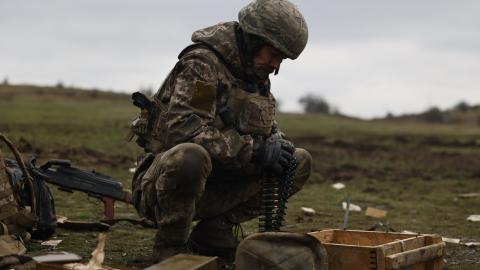Winter has arrived in Ukraine, and there is no indication that this year will be any easier for civilians than the last. Russia has been holding back its air strikes against Ukraine in recent months to build up a larger inventory of missiles and drones for use this winter. In the past week, air strikes have increased noticeably.
Meanwhile, snow already covers much of the ground in eastern Ukraine. Where freezing temperatures have not yet arrived, a sea of mud covers the battlefield. This makes the trench warfare in Ukraine miserable for the soldiers on both sides of the conflict.
Thousands of kilometers away in Washington, DC, American lawmakers are debating whether to send more aid to Ukraine. So far, the US has spent around $113 billion on aid for Ukraine over the course of 22 months. While on the face of it this seems like a large amount, it equates to about 0.03 percent of America’s gross domestic product during the same period. Also, approximately $70 billion of the aid will never leave the US. Instead, it remains in the US supporting the American defense industry and creating well-paid jobs.
However, what started as a bipartisan issue in the early days of the conflict has since become a partisan matter plagued by the usual politics in Washington.
Ukraine should not despair. Even though the critics of additional aid to Ukraine are vocal, they remain a minority. Between the two major parties, the Democrats and the Republicans, there remains enough support in Congress for additional aid to Ukraine. This reflects the mood of the American people too. A poll released by the Reagan Foundation this week revealed that three-quarters of Americans believed it was important that Ukraine won the war against Russia’s invasion. This included 71 percent of Republican respondents agreeing.
When asked if the US should continue sending weapons and munitions to Ukraine, almost 60 percent of Americans supported doing so, but only 50 percent of Republicans agreed. While the lower number from Republican respondents might be alarming when taken at face value, it actually paints a positive picture.
Russia’s invasion of Ukraine is now in its 22nd month and US support for Ukraine is viewed by most Americans as being an initiative of President Joe Biden’s administration. So, the fact that 50 percent of Republicans still support the Biden administration’s policy of arming Ukraine is extraordinary. There is no other example where such a large percentage of Republicans support an initiative being led by Biden.
For example, another recent poll showed that only 16 percent of Republicans supported his economic policies. Also, the new speaker of the US House of Representatives, Mike Johnson, recently signaled his support for additional aid to Ukraine. After Johnson was voted into the job last month, there were concerns he would block or delay a vote for more US aid to Ukraine. He has been one of a handful of Republicans who have, over the past year, consistently voted against aid to Ukraine.
However, since taking on the speaker’s role Johnson has shifted his position. This week he told journalists he was “confident and optimistic” that Congress would pass additional aid. He said: “Of course, we can’t allow (Russian President) Vladimir Putin to march through Europe. And we understand the necessity of assisting there (Ukraine).”
There also remains strong support in Europe for aiding Ukraine. In fact, recent data published by the respected Kiel Institute showed that European commitments to Ukraine were now double that of America’s. As a percentage of GDP, 20 European countries ranked before the US when it came to the amount of aid provided to Ukraine.
Of course, there are the outliers. Slovakian elections in October saw a pro-Russian populist party form a new government. This week’s elections in the Netherlands also saw a far-right party, that wants to stop aid to Ukraine, win the most seats. In both cases, coalitions with other political parties are required before forming a government.
This means that the anti-Ukrainian rhetoric voiced by some political parties during the campaign may not translate into major changes in Ukraine policy when a new government is formed. Meanwhile, support for arming Ukraine in Europe’s larger countries such as the UK, Germany, Poland, Italy, and Romania remains strong. In recent weeks, officials from these European countries and others have been visiting Washington to make the case to US lawmakers for more aid to Ukraine.
Most Americans are worried about the bread-and-butter issues of daily life. High inflation, an increase in the price of groceries, access to affordable healthcare, and good education for children are the top issues driving US voters to the polls. In fact, most Americans do not think about Ukraine or even foreign policy issues from day to day. This is why leadership from the White House and Congress is so important when it comes to maintaining support for Ukraine.
Ukraine’s highly anticipated counteroffensive that started earlier this year has not met expectations. Russia is increasing its military spending to historically high levels and has shown no desire to enter negotiations with Ukraine. It is unlikely that 2024 will be a year of peace for Ukraine. So, as winter sets in, and as Congress heats up the debate about additional aid, the war is entering a crucial period for Ukraine.
Now is not the time for Western support to be put into jeopardy or for Western policymakers to dither on additional aid for Ukraine.



















